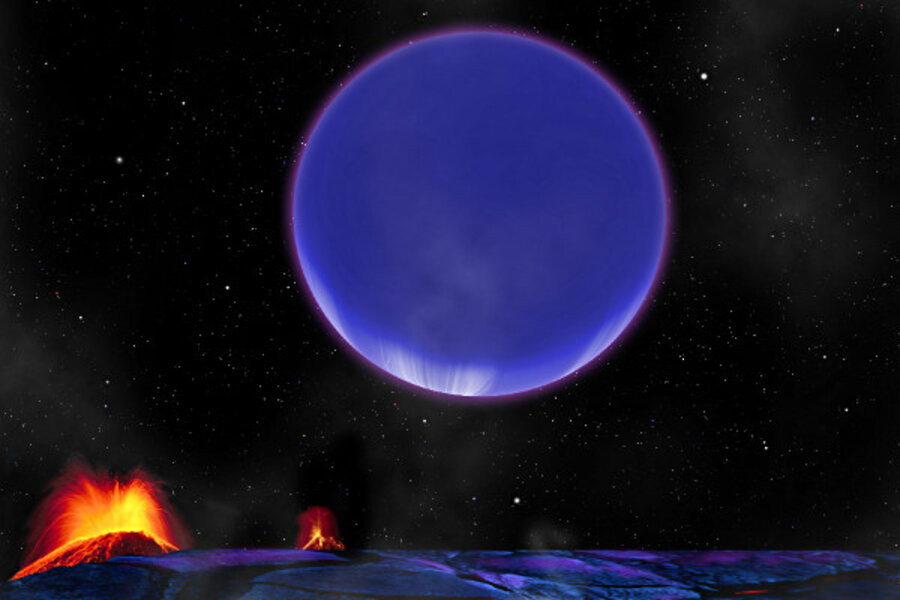Astronomers spot pair of planets dancing the lambada
Loading...
Imagine if the Neptune was only a million miles from Earth. What a view we’d have! … not to mention some incredible gravitational effects from the close-by, gigantic planet. A similar scenario is taking place for real in star system in the constellation Cygnus.
A newly found planet duo orbiting a sun-like star come together in extremely close proximity, and strangely enough, the two planets are about as opposite as can be: one is a rocky planet 1.5 times the size of Earth and weight 4.5 times as much, and the other is a gaseous planet 3.7 times the size of Earth and weighing 8 times that of Earth.
“They are the closest to each other of any planetary system we’ve found,” said Eric Agol of the University of Washington, co-author of a new paper outlining the discovery of this interesting star system by the Kepler spacecraft. “The bigger planet is pushing the smaller planet around more, so the smaller planet was harder to find.”
Known as Kepler-36, the star is a several billion year older than our Sun, and at this time is known to have just two planets.
The inner rocky world, Kepler-36b orbits about every 14 days at an average distance of less than 11 million miles, while the outer gas “hot Neptune” planet orbits once each 16 days at a distance of 12 million miles.
The two planets experience a conjunction every 97 days on average. At that time, they are separated by less than 5 Earth-Moon distances. Since Kepler-36c is much larger than the Moon, it presents a spectacular view in its neighbor’s sky. And the science team noted that the smaller Kepler-36b would appear about the size of the Moon when viewed from Kepler-36c).
But the timing of their orbits means they’ll never collide, Agol said. However close encounters of this kind would cause tremendous gravitational tides that squeeze and stretch both planets.
The larger planet was originally spotted in data from NASA’s Kepler spacecraft, which uses a photometer to measure light from distant celestial objects and can detect a planet when it transits, or passes in front of, and briefly reduces the light coming from, its parent star.
The team wanted to try finding a second planet in a system where it was already known that there was one planet. Agol suggested applying an algorithm called quasi-periodic pulse detection to examine data from Kepler.
The data revealed a slight dimming of light coming from Kepler-36a every 16 days, the length of time it takes the larger Kepler-36c to circle its star. Kepler-36b circles the star seven times for each six orbits of 36c, but it was not discovered initially because of its small size and the gravitational jostling by its orbital companion. But when the algorithm was applied to the data, the signal was unmistakable.
“If you look at the transit time pattern for the large planet and the transit time pattern for the smaller planet, they are mirror images of one another,” Agol said.
The fact that the two planets are so close to each other and exhibit specific orbital patterns allowed the scientists to make fairly precise estimates of each planet’s characteristics, based on their gravitational effects on each other and the resulting variations in the orbits. To date, this is the best-characterized system with small planets, the researchers said.
From their calculations, the team estimates the smaller planet is 30 percent iron, less than 1 percent atmospheric hydrogen and helium and probably no more than 15 percent water. The larger planet, on the other hand, likely has a rocky core surrounded by a substantial amount of atmospheric hydrogen and helium.
The planets’ densities differ by a factor of eight but their orbits differ by only 10 percent. The big differences in composition and the close proximity of the two is quite a head-scratcher, as current models of planet formation don’t really predict this. But the team is wondering if there are more systems like this out there.
“We found this one on a first quick look,” said co-author Josh Carter, a Hubble Fellow at the Harvard-Smithsonian Center for Astrophysics (CfA). “We’re now combing through the Kepler data to try to locate more.”
Nancy Atkinson is Universe Today's Senior Editor. She also is the host of the NASA Lunar Science Institute podcast and works with the Astronomy Cast and 365 Days of Astronomy podcasts. Nancy is also a NASA/JPL Solar System Ambassador.
Connect with Nancy on Facebook | Twitter | Google + | Website





